 Hungerford Arcade stallholder, Adam Thompson (Unit 50) is holding a Vinyl Record Valuation day this Saturday at the Arcade. Do come along with your record(s) and he will tell you their value. Adam also buys records if you wish to sell them.
Hungerford Arcade stallholder, Adam Thompson (Unit 50) is holding a Vinyl Record Valuation day this Saturday at the Arcade. Do come along with your record(s) and he will tell you their value. Adam also buys records if you wish to sell them.
 Hungerford Arcade stallholder, Adam Thompson (Unit 50) is holding a Vinyl Record Valuation day this Saturday at the Arcade. Do come along with your record(s) and he will tell you their value. Adam also buys records if you wish to sell them.
Hungerford Arcade stallholder, Adam Thompson (Unit 50) is holding a Vinyl Record Valuation day this Saturday at the Arcade. Do come along with your record(s) and he will tell you their value. Adam also buys records if you wish to sell them.
ANTIQUES & COLLECTABLES
Today, Monday, 23rd June is Armed Forces Day in the UK.
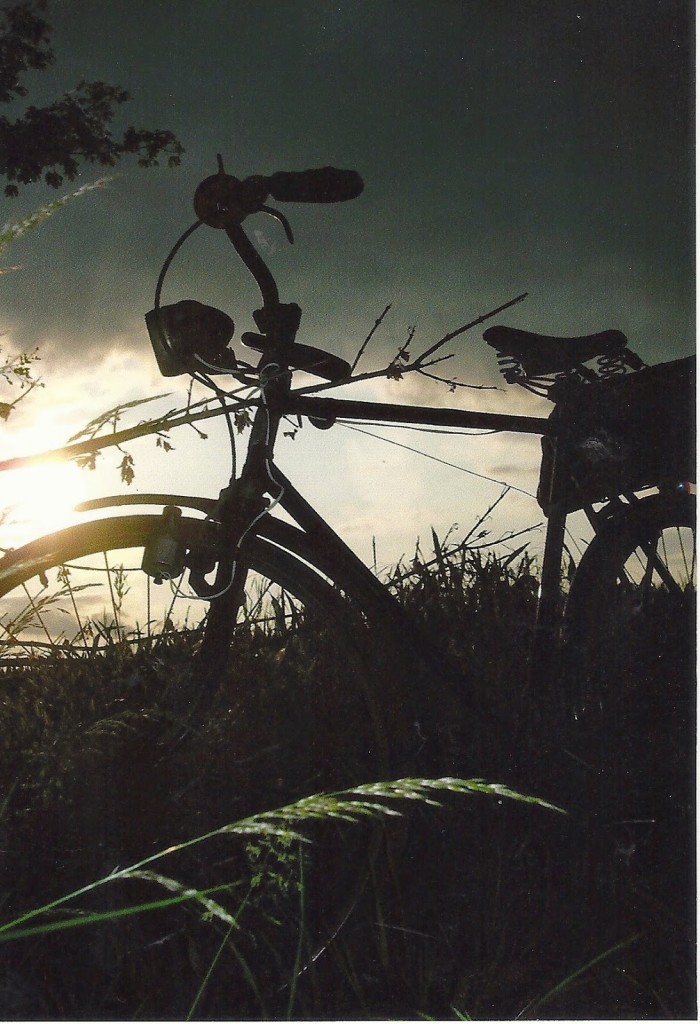 My fascination with bicycles began in 1975 when my parents gave me a Raleigh Chopper for my 8th Birthday. Freedom at last to travel with no constraints. I remember that I used to ride along a track beside the seafront at Hamble and watched the QE2 as she left Southampton waters. The beach was only a ten minute bike ride away, but an hour on foot.
My fascination with bicycles began in 1975 when my parents gave me a Raleigh Chopper for my 8th Birthday. Freedom at last to travel with no constraints. I remember that I used to ride along a track beside the seafront at Hamble and watched the QE2 as she left Southampton waters. The beach was only a ten minute bike ride away, but an hour on foot.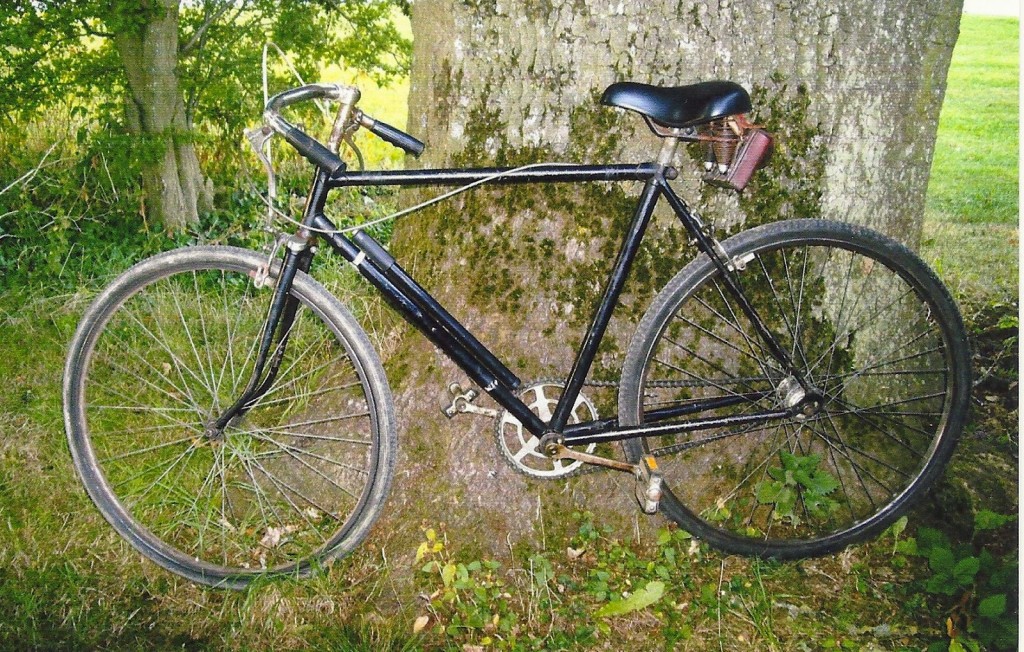
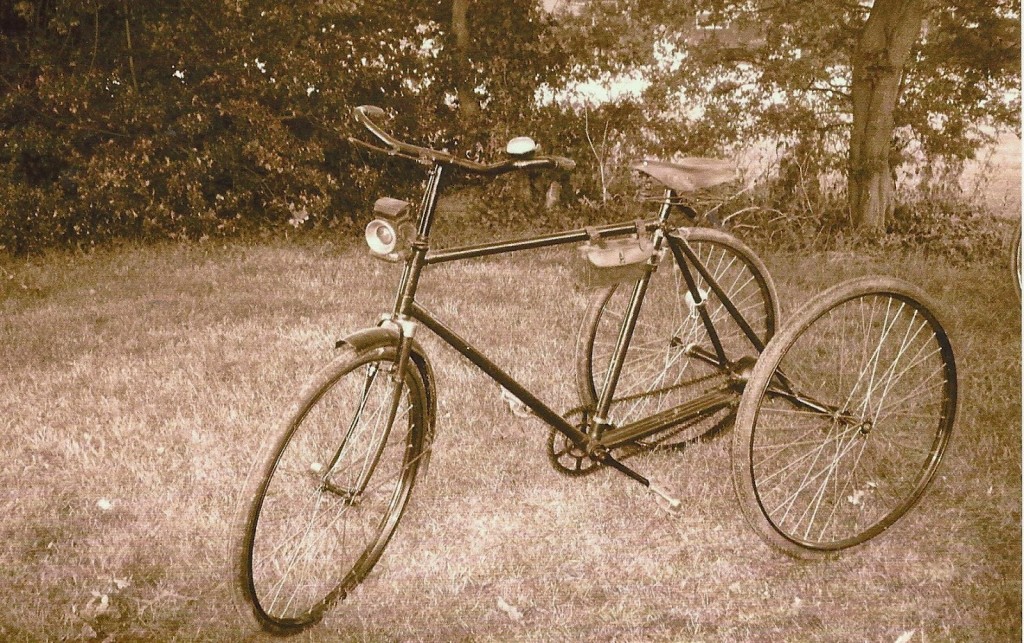 Fast forward 36 years to 2011 when I visited my first Early Cycling Auction, the Michael Radford collection at Reading. My passion for cycling was reignited as I viewed the bikes and tricycles from the mid-Victorian time right up to the 1950’s – spanning a whole century. At the time, I wanted to buy at least 10 bikes and trikes, but due to constraints on storage space, I settled on a pair of tricycles. A 1920’s Abingdon King Dick and a 1950’s James Fothergill touring tricycle with cyclo three speed deurralier.
Fast forward 36 years to 2011 when I visited my first Early Cycling Auction, the Michael Radford collection at Reading. My passion for cycling was reignited as I viewed the bikes and tricycles from the mid-Victorian time right up to the 1950’s – spanning a whole century. At the time, I wanted to buy at least 10 bikes and trikes, but due to constraints on storage space, I settled on a pair of tricycles. A 1920’s Abingdon King Dick and a 1950’s James Fothergill touring tricycle with cyclo three speed deurralier.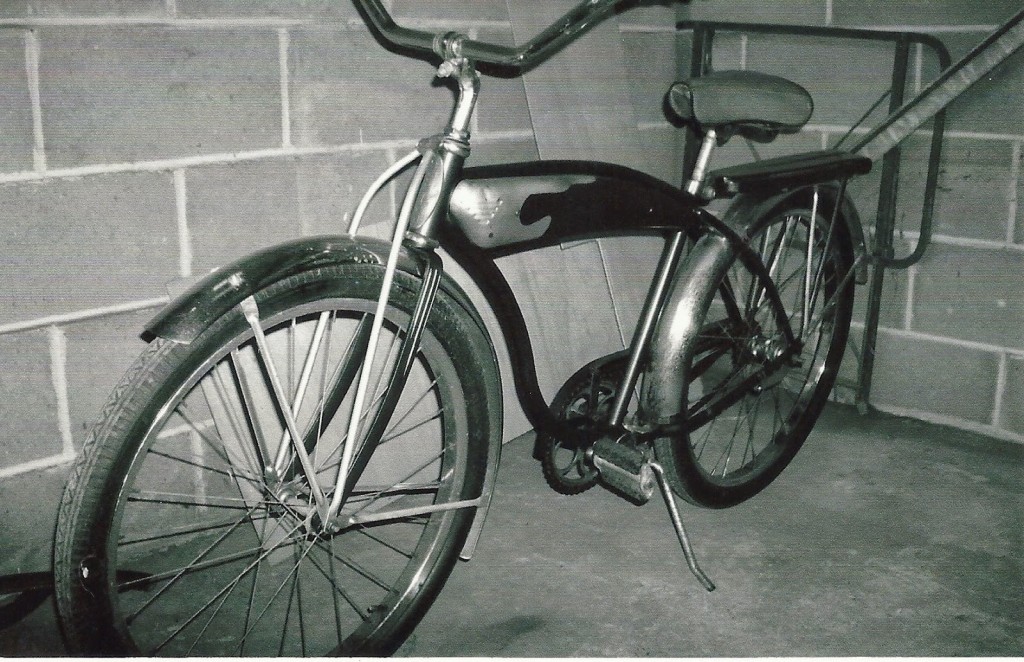
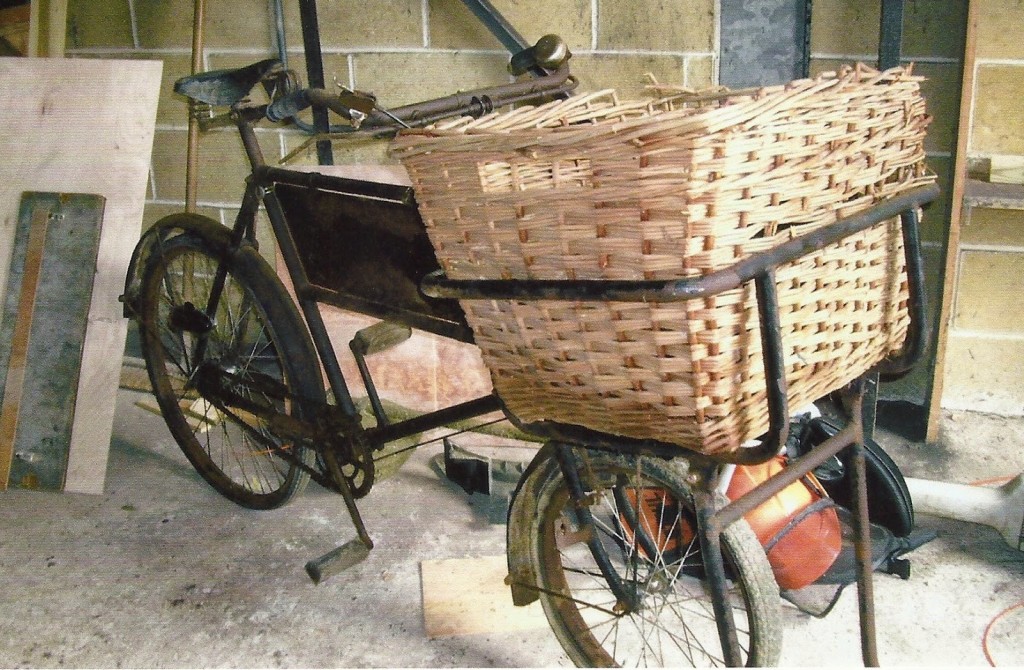 Since then, I have amassed almost 30 bikes and trikes including three butchers bikes, a Japanese racing bike, Hercules Balmoral, Elswick, the inevitale Raleigh “all steel”, an RAF base bicycle, BSA’s and Raleigh 20’s – the ubiquitous shopping bike. The wonderful thing is, they are all usable and practical – in fact, an 80 year old three speed BSA is probably better to ride than most modern bikes. It is more comfortable and easier to ride up hills than your average Mountain Bike or more expensive light weight road bike.
Since then, I have amassed almost 30 bikes and trikes including three butchers bikes, a Japanese racing bike, Hercules Balmoral, Elswick, the inevitale Raleigh “all steel”, an RAF base bicycle, BSA’s and Raleigh 20’s – the ubiquitous shopping bike. The wonderful thing is, they are all usable and practical – in fact, an 80 year old three speed BSA is probably better to ride than most modern bikes. It is more comfortable and easier to ride up hills than your average Mountain Bike or more expensive light weight road bike. 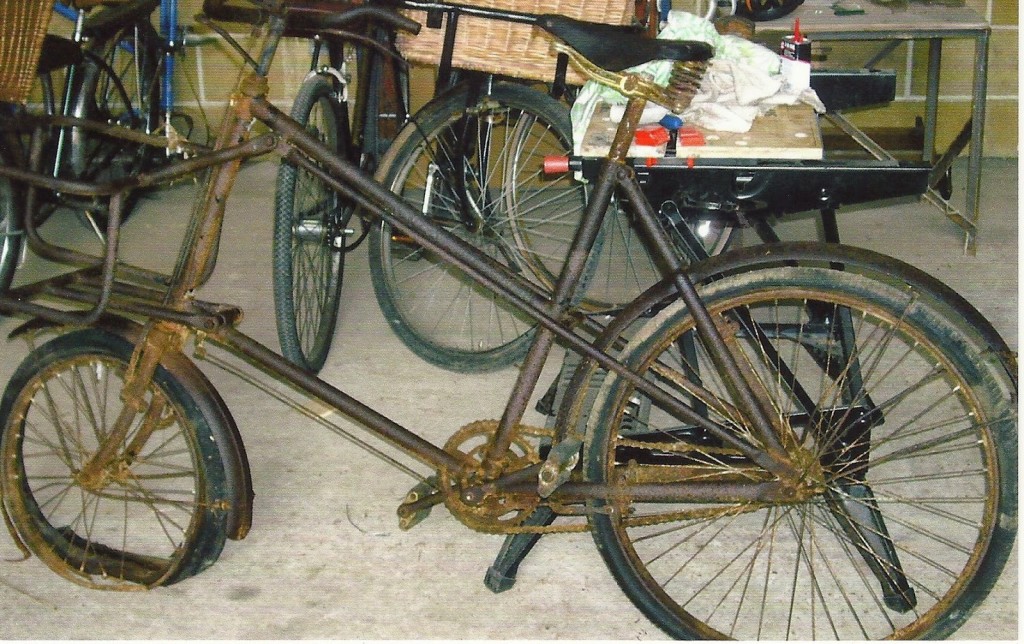 In the two World Wars, bicycles were an important form of transport for all the armies around the world. Even now, the Swiss Army use the “Swiss Army bike” as well as the Swiss Army knife. They are also used by the Police, Paramedics (especially in built-up areas like London), Couriers and even Taxi firms – again, especially in London.
In the two World Wars, bicycles were an important form of transport for all the armies around the world. Even now, the Swiss Army use the “Swiss Army bike” as well as the Swiss Army knife. They are also used by the Police, Paramedics (especially in built-up areas like London), Couriers and even Taxi firms – again, especially in London. To sum up, the bicycle is the link between the horse and cart and the car. It was here before the motorcycle and has provided cheap and reliable transport for the masses since its invention. In its heyday, the bike was a feat of engineering and design, many being used as advertising gimmicks and fashion statements to this day. Take the Pashley Guvnor – modern take on the 1930’s Path Racer. A work of art in its own right, made by a British firm and a lovely bike to ride. What more could you ask for? All this and they keep you fit, are cheap (free) to run and can last forever!
To sum up, the bicycle is the link between the horse and cart and the car. It was here before the motorcycle and has provided cheap and reliable transport for the masses since its invention. In its heyday, the bike was a feat of engineering and design, many being used as advertising gimmicks and fashion statements to this day. Take the Pashley Guvnor – modern take on the 1930’s Path Racer. A work of art in its own right, made by a British firm and a lovely bike to ride. What more could you ask for? All this and they keep you fit, are cheap (free) to run and can last forever!For all the latest news, go to our Newsletter at www.hungerfordarcade.co.uk
 |
| “George the Wheel” (right) with a representative from Morgan Motor Company (left) in the early 1980s |
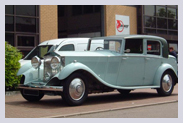
 Dan Cooksley is the Workshop Manager for Motor Wheel Service International. Renowned worldwide, the company was founded at Becklow Road, Shepherds Bush, London in 1927. George Smith (aka George the Wheel) took ownership of the company in 1947 and it has remained a family owned business to this day.
Dan Cooksley is the Workshop Manager for Motor Wheel Service International. Renowned worldwide, the company was founded at Becklow Road, Shepherds Bush, London in 1927. George Smith (aka George the Wheel) took ownership of the company in 1947 and it has remained a family owned business to this day.
 This is a fascinating company. They can restore almost any wire wheel ever made. They also build wheels for specialist cars. In 1998 the company moved its Headquarters to Langley, Slough and in 2012, MWS celebrated their 85th Anniversary.
This is a fascinating company. They can restore almost any wire wheel ever made. They also build wheels for specialist cars. In 1998 the company moved its Headquarters to Langley, Slough and in 2012, MWS celebrated their 85th Anniversary.
Liverpool
Creamware Pottery
“
I am all for the short and merry life” (Fitzgerald)
When
one thinks of Liverpool, one thinks of The Beatles, the two football
clubs and maybe of Cilla Black, but how many of us consider a
Liverpool pottery. But yes, there was one once located in the
unfashionable suburb of Toxteth next to the River Mersey. It has been
closed for over one hundred and seventy years but its impact is still
being felt.
Whilst
I had heard of Creamware, it was not until recently that I found out
about the short life of the Liverpool Pottery and when researching
the subject I found something of a Pandora’s Box of information
hidden just under the surface.
I
have only been to (or through) Toxteth twice in my life, both times
when returning from football matches. Like many areas it has suffered
over the years and would be the last place that you would connect
with a pottery. Yet, its location next to the river was by far the
most logical place for it to be. If you were looking for it now then
you would be hard pressed to find any trace of it as after its
closure in 1840, the area in time became what was known as the
Herculaneum Dock (it
even had its own station on the network of the famed Liverpool
Overhead Railway)
before the dock in turn closed in 1972. I am told that the area is
now covered by a riverside development as well as being used for
the Liverpool
Garden Festival.
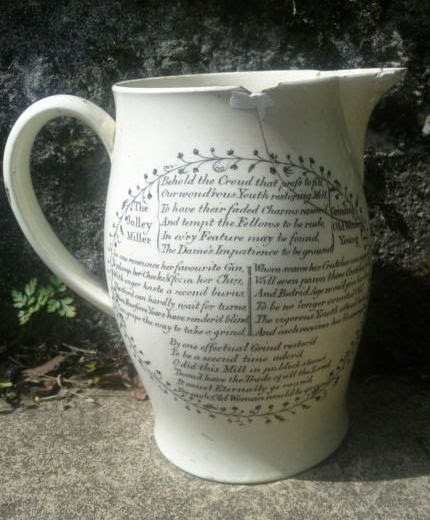 Creamware
Creamware
Their
early productions were of printed earthenware, which, because of its
deeper shade could be differentiated from Josiah’s products. As I
have already noted the location of the pottery on the shores of the
Mersey was important as the business did a very good trade with
America. Many of the early designs were devoted to American themes.
English themes were also produced with landscapes being especially
popular.
 As
As
It
was a brave attempt in the first instance and for a few short years
it was a shining light in Liverpool. If I am not mistaken, there would
have been other much smaller potteries dotted around the country but
like The
Herculaneum Pottery, these
would have been swallowed up by much bigger concerns. We all like the
idea of small independent businesses but what is true today, was just
as true then.
 Although
Although
I do not collect Creamware one of the features that I do enjoy is the
actual freshness of the design and the lack of actual colour. There
is an example at the V&A of a Creamware plate dating from
c1780/90. On a first viewing the plate looks almost under designed
but on closer study the design is quite complex. Two peacocks and an
unidentified bird in flight are featured but the positioning of the
birds and use of the foreground detritus and the background trees
(not forgetting the bird in flight) together present an exquisite
scene. The bordering of the plate only adds to the effect.
Whilst
Herculaneum and other potteries did not exclusively work in
monochrome, (blue was often used especially when copying Chinese
patterns) the effect of what could be loosely termed black
on white was
quite memorable. Whilst researching this article, I have found many
examples of the Liverpool pottery. Some of the earlier ones are in
their way quite haunting. When showing scenes (of the areas around
Liverpool for instance) there is a vacancy, yet the views are full of
detail. Where buildings and the urban sprawl now exist, there were
fields and the area was as rural as the areas around Hungerford are
today. The medium was perfect for this representation.
As
tastes changed in the nineteenth century, in my view, the designs
became very complicated and the simplicity of the earlier works was
lost. Many people like these baroque designs but whilst appreciative, they are not for me. It is almost looking back into your childhood
and thinking of Those
Blue Remembered Hills.
Scenes
of the rural life were not the only decorations applied to the works
from Herculaneum. The medium presented myriad opportunities. If there
was a grand civic event then this would have been recorded on the
commemorative pottery of the day. Obviously, anything royal would have
been celebrated. As Liverpool was the gateway to America and the last
city many emigrants saw before they left, it is likely that the
many ships may have been represented (although I have not seen
examples). The trade of the city would have been celebrated
also.
Liverpool
was foremost an industrial city and with this came the rise of the
trade unions who, as they do today, tried to ensure that the average
working man was treated fairly and with the respect due to him. As
these unions grew then they too celebrated their achievements and
commissioned various items of pottery (jugs etc) to commemorate
themselves.
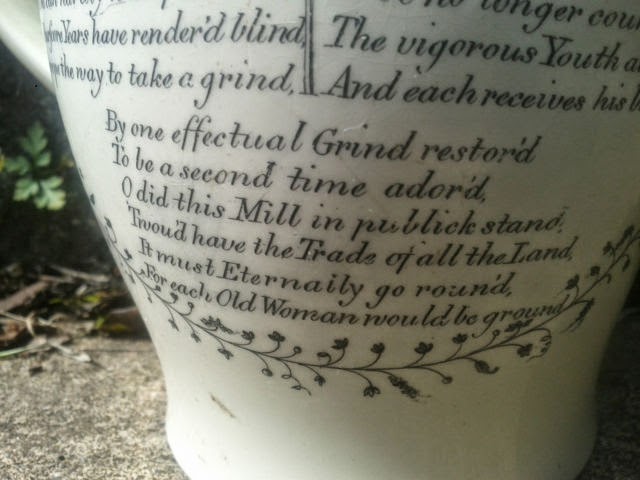 One
One
thing that the people in Liverpool are renowned for is their sense of
humour and an example that I recently noted was the Old
Maids into New Maidens theme
that was frequently used. There are very likely to have been many
variations on this theme and explorations into the lands of
Hogarthian and Liverpool wit. Figures of fun such as jesters would
have been represented widely as well as, I would imagine, satires on
many famous Victorian figures.
Obviously
due to the relatively short lifespan of the Herculaneum
Pottery, the
pieces produced are highly collectable and sought after. I believe
that there are examples in a museum in Liverpool as these are prized
relics of the city’s past. The exportation of many works to the USA
and Canada also means there is a market overseas and this in turn
will drive the prices higher. I have looked on the internet and there
is a whole raft of prices but some of the pieces on sale do look
quite worn. It is very much like most things, the better the
condition of the item (and taking into account its rarity) the more
one is likely to pay.
It
is not an item that you are likely to come across at a boot sale or jumble
sale (although never say never). You are more likely to see examples
in antique establishments. If you know what you are looking for then
you will know your purse. If I was to buy a piece of Liverpool
Creamware, then I think I would choose an early piece (pre1806). I
would not greatly care of its condition as I would like to connect
with its origins in Toxteth next to the River Mersey, before this area
was swallowed up by the city of Liverpool.
Our great author, Stuart Miller-Osborne gets the idea for his articles from many different sources. Here we have a story which came into being by a visit to Bath. It is brilliant and I hope you enjoy it as much as I did.
Rita
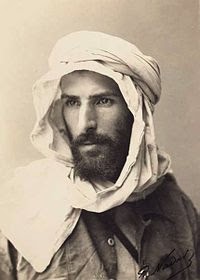 What attracted me to Pierre was the account of his manner, totally unique in the explorers of his day. He is recorded as having a charming personality and although European, was able to blend in with ease with the Africans he encountered and was known to walk through the jungle barefoot as his hosts would have done.
What attracted me to Pierre was the account of his manner, totally unique in the explorers of his day. He is recorded as having a charming personality and although European, was able to blend in with ease with the Africans he encountered and was known to walk through the jungle barefoot as his hosts would have done.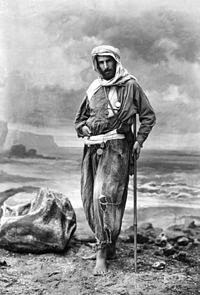 Spurred on by this, a second one was soon proposed. This took place from 1879 to 1882 and really was a benign attempt to spread French influence in the areas explored. The idea was to ensure that as many kingdoms as possible were placed under the French flag without straying across other European borders. One must remember that although far from perfect the French aims were not as hostile as some other European influences in the area.
Spurred on by this, a second one was soon proposed. This took place from 1879 to 1882 and really was a benign attempt to spread French influence in the areas explored. The idea was to ensure that as many kingdoms as possible were placed under the French flag without straying across other European borders. One must remember that although far from perfect the French aims were not as hostile as some other European influences in the area.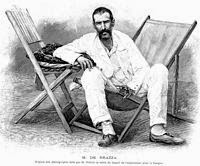 Pierre reached the River Congo in 1880 and not long after met Stanley and whilst they did not become firm friends, they respected each other although I am led to believe, that Stanley was rather surprised that Pierre and his peaceful methods had succeeded so well.
Pierre reached the River Congo in 1880 and not long after met Stanley and whilst they did not become firm friends, they respected each other although I am led to believe, that Stanley was rather surprised that Pierre and his peaceful methods had succeeded so well. 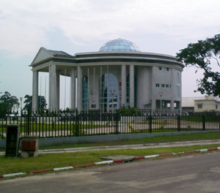 This however was not the last of Pierre’s post death travels for on the 30th September 2006, his remains were exhumed once again (along with those of his wife and children) and returned to Brazzaville to be placed at rest in a new marble mausoleum. This caused controversy due to the cost (in the region of five million pounds) and that the Congolese who fought for independence were ignored.
This however was not the last of Pierre’s post death travels for on the 30th September 2006, his remains were exhumed once again (along with those of his wife and children) and returned to Brazzaville to be placed at rest in a new marble mausoleum. This caused controversy due to the cost (in the region of five million pounds) and that the Congolese who fought for independence were ignored.  Strangely enough one can, if they look hard, still find memorabilia connected with De Brazza. He was an extremely handsome man and to finance some of his expeditions had photographs taken by Nadar, amongst others. He was celebrated on postcards and stamps and even had a ship named after him, the Savorgnan De Brazza. His letters are collected in books and there are many other artefacts to be found.
Strangely enough one can, if they look hard, still find memorabilia connected with De Brazza. He was an extremely handsome man and to finance some of his expeditions had photographs taken by Nadar, amongst others. He was celebrated on postcards and stamps and even had a ship named after him, the Savorgnan De Brazza. His letters are collected in books and there are many other artefacts to be found.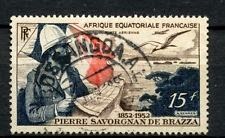 I have not yet found any of these items in Hungerford yet but I will keep on looking. As I left that small antique market in Bath it started to rain. I had covered the trunk in its sacking again so that the small chalk destination would remain on its decaying surface at least for a few more years.
I have not yet found any of these items in Hungerford yet but I will keep on looking. As I left that small antique market in Bath it started to rain. I had covered the trunk in its sacking again so that the small chalk destination would remain on its decaying surface at least for a few more years.  |
| Winston Churchill |
The owners, managers, staff and all the stallholders at Hungerford Arcade join in the celebrations of the D Day Landings which took place 70 years ago on 6th June 1944. We honour the brave soldiers, sailors and airmen of Great Britain, the Commonwealth and our Allies. Because of them and those who never returned home, we can enjoy the freedom we have today.
Rita
| Lest we forget British and Commonwealth Graves Bayeux war Cemetary |
For all the latest news, go to our Newsletter at www.hungerfordarcade.co.uk
We had a very special couple visit us at Hungerford Arcade recently, Natasha Daguiar and her partner, Steve who had a marvellous story to tell us about a four week old baby fox which, when found, was very near to death. I am sure when you read their story and look at the photographs, you too, will agree they are special.
Rita
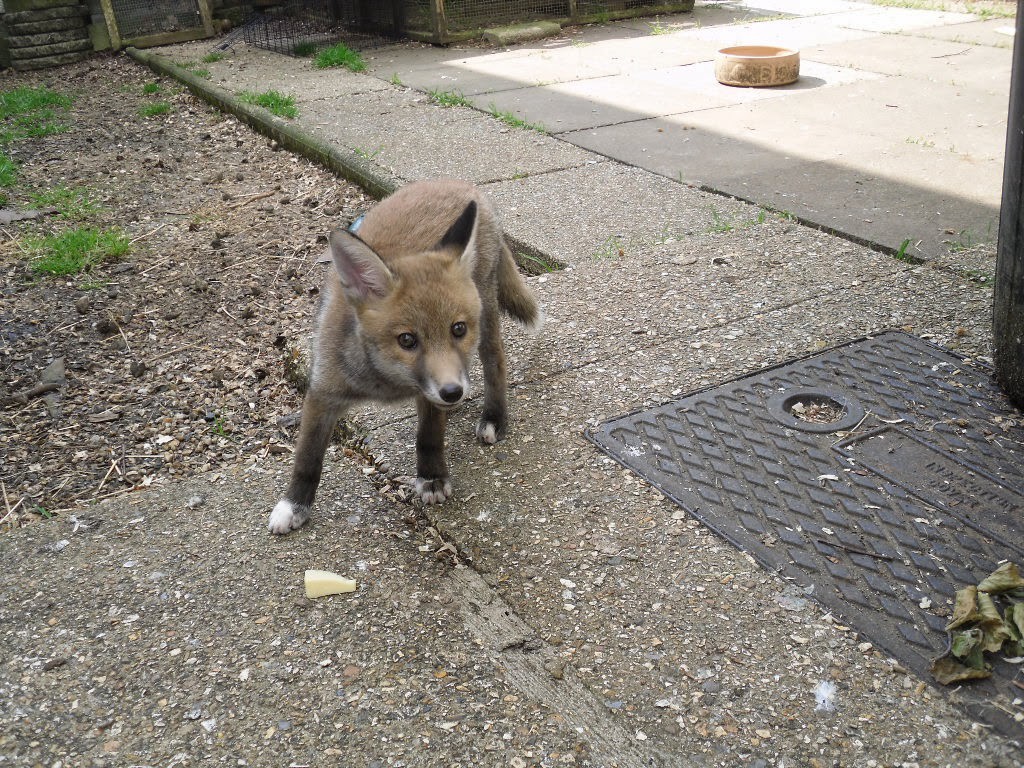 |
| Fox Cub, Jade |
Of course, we said yes. We were told this tiny fox cub was found in a field by a lady walking her dog. The lady had noticed it the day before but left it in case Mum fox was nearby. On visiting the same site approx 16 hours
later, the lady found the tiny cub was still in the same spot. This is when the fox cub was brought into the vets.
I instantly done as much research online as I possibly could. We knew this cub would be weak and in dire need of help. My partner, Steve set off to pick up the young cub and some electrolytes from the vets and I headed out to purchase some Goats milk. When Steve got the cub home we were both shocked by the terrible state this young animal was in. She was lifeless, clinging on to minimal signs of life. She could not lift her head and could barely move her tongue. We began syringe feeding her the goats milk mixed with probiotics and electrolytes. It was painstaking and we felt given our previous experiences of wild animals, this little cub had an extremely small chance of surviving. We wouldn’t give up as long as she was hanging on in there. After a few messy feeds at very frequent intervals, we started to see this little cub show some very positive signs of life. Her licking was getting stronger, her little head lifted and we were amazed and delighted with her progress. Although we still couldn’t say she was out of the woods. We got the cub home at approx 7pm and by about 12am she was starting to walk, although very wobbly. We kept up the frequent goat milk feeds every half hour to an hour all through the night. This cub also had one fit/seizure during the night. We had not experienced this before in any animal and were shocked at the severity. I did some more research online regarding fits and we thought it best to take her to the vets for medication and a course of antibiotics in case she had toxoplasmosis. She had further fits approx 4 in 24 hours. At the vets all appeared good, this little cub was walking well, much stronger but we had to stop these fits. She also had cloudy eyes and when the vet tried to look she could not get a good view as the fox kept the inside lids down. We were aware she bumped into things in a clumsy manner, the vet said even very young puppies can appear blind because of their clumsiness. We hoped for the best.
Whilst doing lots of research online, I had stumbled across the importance of taurine. I was totally unaware that foxes and cats alike cannot regulate their own taurine as dogs and humans can. We knew taurine was found in the fox’s natural food and so we purchased some taurine supplements. I forgot to mention by the second day of having this little cub which we decided to name Jade, she was willingly eating soft dog food mixed with goats milk, electrolytes, probiotics and taurine. This was fantastic as we could get a lot more food inside her than with the syringe feeding.
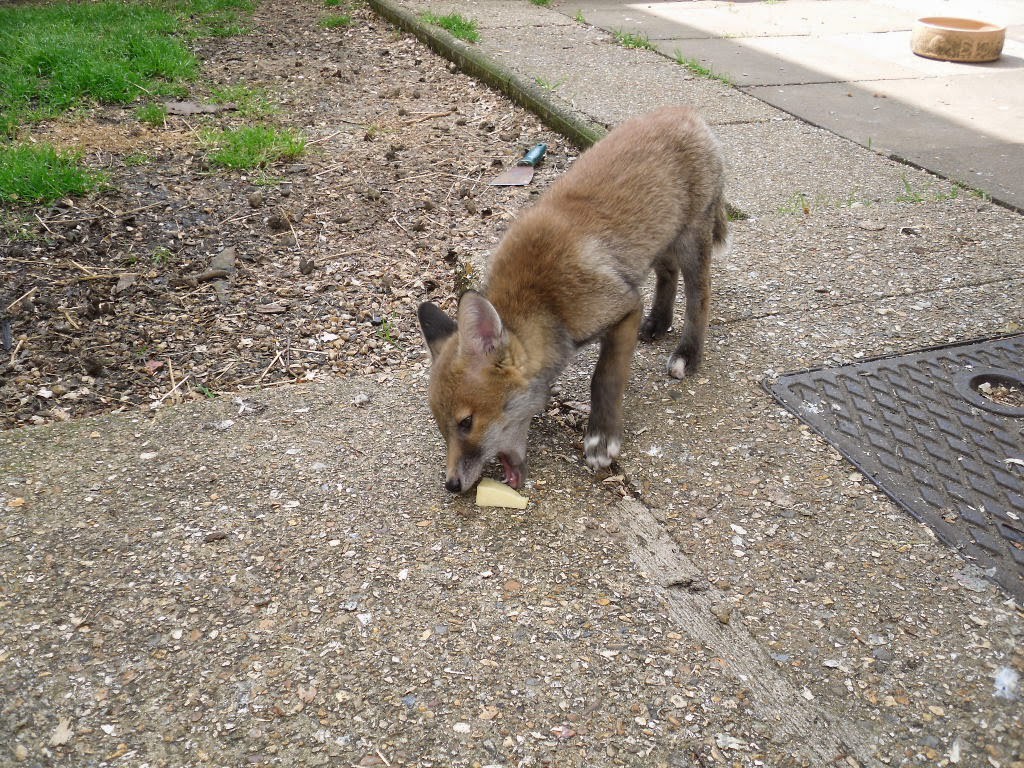 Jade is growing at a very rapid rate, we cannot believe this is the same little cub that came to us just over 7 weeks ago. We estimate that she was approx 4 weeks old when she arrived with us. So we believe she is now 11 weeks old. We have an indoor enclosure for Jade as well as her larger outdoor enclosure, she has also been on small walks with our 2 dogs. We are going at Jade’s pace and we will let her teach us what she wants and needs as she grows. Jade also enjoys rough play with our elderly Staffordshire Bull Terrier who thinks she’s still a puppy! We tell Solo the staffie to leave Jade and then Jade will pounce on her and terrorise her, they are funny together. We have excluded our male Staffordshire bull terrier Buzz from this close contact play as we know Jade will terrorise him too and we don’t know how he will react without the maternal instincts our female Solo has. Jade has contact with Buzz from inside her enclosures and whilst out walking where she is restrained from pouncing all over Buzz. He is a very good natured dog but we don’t want to rush his and Jade’s relationship as she will mellow out when a little older and then he won’t be over powered by her tormenting sharp teeth.
Jade is growing at a very rapid rate, we cannot believe this is the same little cub that came to us just over 7 weeks ago. We estimate that she was approx 4 weeks old when she arrived with us. So we believe she is now 11 weeks old. We have an indoor enclosure for Jade as well as her larger outdoor enclosure, she has also been on small walks with our 2 dogs. We are going at Jade’s pace and we will let her teach us what she wants and needs as she grows. Jade also enjoys rough play with our elderly Staffordshire Bull Terrier who thinks she’s still a puppy! We tell Solo the staffie to leave Jade and then Jade will pounce on her and terrorise her, they are funny together. We have excluded our male Staffordshire bull terrier Buzz from this close contact play as we know Jade will terrorise him too and we don’t know how he will react without the maternal instincts our female Solo has. Jade has contact with Buzz from inside her enclosures and whilst out walking where she is restrained from pouncing all over Buzz. He is a very good natured dog but we don’t want to rush his and Jade’s relationship as she will mellow out when a little older and then he won’t be over powered by her tormenting sharp teeth.Our dear author, Stuart Miller-Osborne and his wife Caron have been celebrating the birth of their second granddaughter, Lily Iris Rose. She was born on 17th May in Paulton near Bath. The managers, staff and stallholders at Hungerford Arcade send our congratulations to Stuart, Caron and their family.
Here is a wonderful story written by Stuart after a recent visit to Edinburgh. It is a beautiful story which tugs at the heart strings.
Rita
 |
| Bobby |
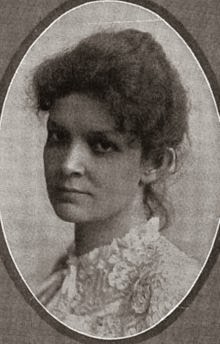 |
| Eleanor Stackhouse Atkinson |
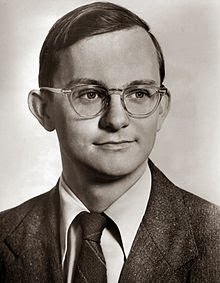 |
| Wally Cox – 1962 |
The city does not sell the attraction heavily which is refreshing but I did see modern copies of the 1912 book and DVDs of the two prominent films that were made, Greyfriars Bobby (1961) starring Gordon Jackson and the later one, The Adventures of Greyfriars Bobby (2006) starring Gina McKee, for sale around the city.
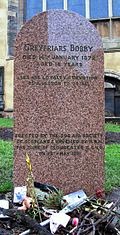 |
| Greyfriars Bobby Headstone |
For all the latest news, go to our Newsletter at www.hungerfordarcade.co.uk